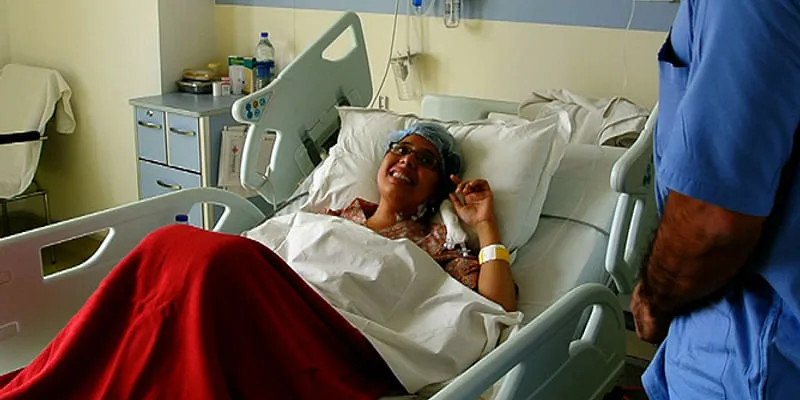Here’s how Vattikuti Foundation is taking robotic surgery to the masses
Based in the US and India, Vattikuti Foundation is a non-profit organisation that is providing the medical fraternity of lower to middle-income countries with some of the most specialised and high-end technologies.
When entrepreneur and philanthropist Raj Vattikuti and his wife Padma Vattikuti immigrated to Detroit, Michigan, they made a commitment to share their wealth to improve the health and well-being of others. They wanted to share a part of their wealth with the society, specifically to Michigan, as that is where their business made money.
Thus, in 1997, they joined hands with their acquaintance, Dr Mahendra Bhandari, to form (VF) with an intention to elevate and promote the idea of well-being among people.
The foundation works to improve the lives of people, specifically the underprivileged sections, through medical and surgical advancements, education, humanitarian relief, and social empowerment initiatives.

The foundation continuously conducts international training activities and forums, leads the adoption of robotic surgery and partners across hospitals in four continents to teach, contribute surgical data, share surgical techniques, and collaborate through professional organisations.
Over the last two decades, thousands of women have received expert diagnosis and care with the technology, equipment, and advancements underwritten by the VF.
While the foundation has operations globally, it has primary presence in India and the United States, while having co-branded network institutions in Belgium and London.
“We don’t interact with patients directly. Instead, our partner facilities act as a link between us and the patients who need our help. In the recent months, we launched a patient education vertical on our website, through which we want to raise awareness among patients about prevalent health concerns and provide information on emerging medical technologies and innovation,” says Mahendra.
He adds that the foundation's primary purpose was to develop a robotic surgical program in India utilising DaVinci and Mako Robots, as well as initiatives promoting social empowerment and financial inclusion.
“We are also committed to the surgeon educational program. We are constantly involved in new technology appraisal and endeavour to bring these to India as early as they are established. Our video library runs in ~800 videos propagating best practices for robotics,” says Mahendra.
The foundation claims to have been able to fabricate a successful base of 70 installations across the country in the past 10 years.
Teaming up
Raj and Padma were the driving forces behind the creation of the foundation. An engineering graduate from Guindy College of Engineering in Computer Science, Raj was able to achieve success in the United States, where he founded many successful publicly listed trading companies.
Meanwhile Padma, an art connoisseur, has served on the Boards of the Merrill-Palmer Institute, Red Cross Southeastern Michigan Chapter, Michigan Asian Business Council, and as a council member of Arts of Asia and Islamic Art at the Detroit Institute of Arts.
The duo then decided to devote a significant portion of their money to cancer care and management, first in Michigan and then in India.
Outside of the resources channelled by the board, the foundation does not accept contributions. Furthermore, the board has constantly pushed to seek innovative projects. Apart from the core team of eight members, the foundation works in tandem with many consultants.
“Our team currently consists of a video editing section, International and national database network managers, and an administrative executive for the operations. We deal with technology a lot; hence we have a tech director. We have director surgeon education, one of the well-known academicians in the field,” adds Mahendra.
The initiatives
With an aim to create an impact within the medical ecosystem, the foundation has established a novel fellowship programme known as the "Vattikuti Fellowship". This initiative offers surgeons a one-of-a-kind surgery fellowship course.
The foundation works on smoothening the interoperability between the knowledge base and practical application by offering young surgeons the opportunity to train with some of the prominent and experienced surgeons in the healthcare industry.

The Vattikuti Fellowship Program
In addition to curating a comprehensive synergy for all the stakeholders in the healthcare sector, the Vattikuti Foundation also focuses on patient education in key areas of concern like cancer and urology.
Besides, the foundation’s research and data wing, called the ‘Vattikuti Collective Quality Initiative’, ensures a collaborative and consistent approach is followed through the data accumulated from 25 centers across the US, India, and Europe.
The credo ingrained within the Vattikuti Foundation is – Philanthropy Making a World of Difference. Today, with 70 installations across India, the platform claims to have positively touched 30,000 households through social initiatives.
So far, the foundation has trained about 50 surgeons through its one year Vattikuti Fellowship program in India. The foundation also assisted the training of 400 surgeons to adopt robotic surgery.
It is also looking to train more surgeons in the field of robotic surgery and increase the number of fellowships it offers.
“The foundation's contributions have had a significant influence in the fields of medical technology and health accessibility. We have multiple testimonials from different stakeholders that give considerable proof of our accomplishments in the area of robotic surgery by bringing several such technologies into the Indian market,” says Mahendra.
The foundation aspires to place a greater emphasis on high-quality publications and to bring modern technology to young medical minds. This would ensure that common people in India would benefit from the services of these doctors, irrespective of their location on the Indian landmass.
Edited by Megha Reddy








